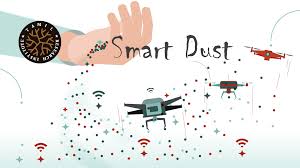
Smart Dust: Tiny Computers Floating in the Air—Fact or Fiction?
Imagine a cloud of microscopic computers, each no larger than a grain of sand, floating invisibly through the air. They monitor your environment, track your movement, communicate with one another—and possibly even relay data in real-time.
This isn’t a sci-fi movie plot. It’s a real technology being developed right now. It’s called smart dust, and it could revolutionize industries—or spark massive debates about privacy and surveillance.
So, what is smart dust really? And is it here yet?
🤏 What Exactly Is Smart Dust?
Smart dust refers to a network of ultra-tiny microelectromechanical systems (MEMS), often smaller than a grain of rice. Each particle—or “mote”—has:
-
A miniature sensor
-
A computer processor
-
A wireless communication unit
-
A power source (often solar or piezoelectric)
These motes can be scattered through the air or embedded into environments, and they work together as a wireless sensor network. It’s essentially a swarm of invisible, self-powered micro-computers.
🧪 Where Did This Idea Come From?
The concept of smart dust was first introduced in the 1990s by researchers at UC Berkeley, backed by DARPA (the same U.S. agency that helped create the internet). The original vision: use dust-sized sensors for battlefield surveillance.
Since then, advances in nanotech and microfabrication have made smart dust smaller, smarter, and more feasible—bringing it closer to real-world deployment.
🔍 What Could Smart Dust Do?
If perfected, smart dust could have a staggering range of applications:
✅ Industrial Monitoring
Smart dust could be sprinkled across a factory or pipeline system to monitor temperature, pressure, or corrosion in real-time.
✅ Agriculture
Dust-sized sensors could measure soil moisture, crop health, and pest activity—all without human intervention.
✅ Healthcare
Imagine motes embedded in the body, tracking internal conditions like blood sugar or inflammation, and transmitting the data wirelessly to doctors.
✅ Smart Cities
Smart dust could monitor traffic, pollution, energy use, and infrastructure health—without bulky hardware.
✅ Military and Surveillance
Yes, the military sees potential too. Smart dust could be used to track troop movement, monitor borders, or gather intel covertly.
🧠 The Tech Behind the Magic
What makes smart dust truly incredible is how self-contained each mote must be. These particles:
-
Generate their own power through light or vibration
-
Communicate with nearby motes using tiny antennas
-
Relay information to central data hubs via wireless mesh networks
-
Work together without a centralized control system
The challenge? Fitting all of this into something smaller than a sesame seed—while keeping it affordable and reliable.
❗ But Is It Real Yet?
Yes—partially. Smart dust prototypes exist, and many components are commercially available. However:
-
Most motes are still millimeters, not microns in size
-
Power limitations make long-term deployment tricky
-
Data transmission over long distances is still a challenge
-
Privacy and ethics concerns have slowed widespread adoption
Companies like Dust Networks (now part of Analog Devices) and researchers at universities worldwide are pushing the tech forward—but we’re not quite at the “cloud of invisible sensors” stage. Yet.
🔒 The Privacy Debate
If smart dust becomes widespread, it opens serious ethical questions:
-
Who controls the data?
-
Can these motes be detected or blocked?
-
How do we prevent unauthorized surveillance?
-
Is there a way to opt-out of invisible monitoring?
These are no longer theoretical concerns. As tech grows more invisible and ambient, transparency and regulation will be critical.
🚀 What’s Next?
Experts predict we’ll start to see more targeted smart dust deployments in industries like oil & gas, aerospace, and healthcare within the next few years. Consumer-level applications may follow as the technology shrinks and becomes more cost-effective.
With the rise of Internet of Things (IoT) devices and artificial intelligence, smart dust could become the ultimate extension of connected living—or a cautionary tale of tech gone too far.
Final Thought
So, is smart dust fact or fiction?
The answer: it’s both.
It’s no longer science fiction—but it’s not quite mainstream reality either. The technology is real, the potential is massive, and the implications—both exciting and alarming—are starting to take shape.
In the very near future, the air around you could be filled with tiny, invisible computers.
The question is: will you even know they’re there?
